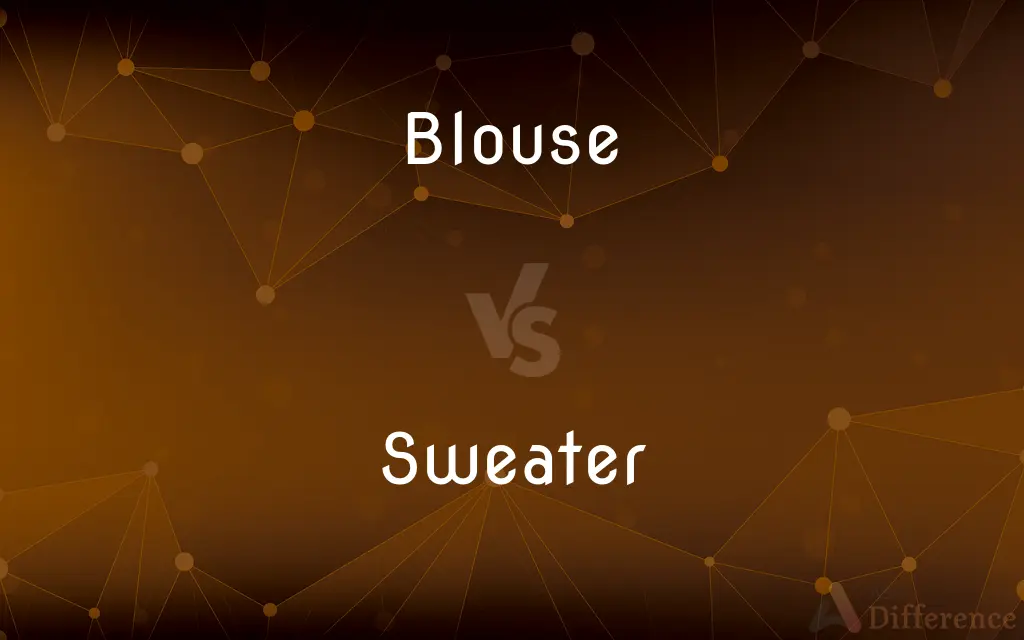Blouse vs. Sweater — What's the Difference?
By Tayyaba Rehman — Updated on December 25, 2023
A blouse is a lightweight, loose-fitting upper garment, typically for women, while a sweater is a knitted garment worn over the upper body for warmth.

Difference Between Blouse and Sweater
Table of Contents
ADVERTISEMENT
Key Differences
A blouse is traditionally a lightweight, loose-fitting garment designed for women, often made from materials like cotton, silk, or synthetic fabrics. Sweaters, on the other hand, are heavier and primarily designed to provide warmth. They are knitted or crocheted and can be worn by all genders.
Blouses are versatile, suitable for formal and casual occasions, and often feature buttons, collars, or decorative designs. Sweaters, characterized by their heavier fabric, are more casual and are essential for colder weather, offering insulation and comfort.
The design of a blouse can vary widely, with styles ranging from simple and understated to elaborate and ornate. Sweaters, while also varied in design, are distinguished by their knitted patterns, thickness, and sometimes by the inclusion of a high neck, known as a turtleneck.
Blouses are typically worn in warmer weather or indoors and can be easily layered under jackets or blazers. Sweaters are often the outer layer in an outfit and can range from lightweight to very thick for harsh winter conditions.
The cultural significance of blouses can vary, with certain styles representing traditional attire in various cultures. Sweaters, while functional in nature, can also hold cultural significance, such as the Irish Aran sweater, known for its unique cable patterns.
ADVERTISEMENT
Comparison Chart
Material
Made from lightweight fabrics like silk, cotton.
Typically knitted from wool, cotton, or synthetic fibers.
Purpose
Fashion and comfort in warmer settings.
Provides warmth and is suitable for colder weather.
Design
Can have buttons, collars, and decorative elements.
Often features knitted patterns and may include a turtleneck.
Wear
Worn as a stand-alone garment or under layers.
Often worn as an outer layer, especially in cold weather.
Cultural Significance
Styles can represent traditional attire in various cultures.
Some, like the Aran sweater, hold cultural significance.
Compare with Definitions
Blouse
A blouse is a loose-fitting upper garment for women.
She wore a silk blouse to the office meeting.
Sweater
A sweater is a knitted garment worn for warmth.
He pulled on a woolen sweater as the temperature dropped.
Blouse
The design of blouses can range from simple to elaborate.
For the party, she picked an ornate blouse with embroidery.
Sweater
Sweaters are made from materials like wool or synthetic fibers.
Her favorite sweater was made of soft, synthetic fleece.
Blouse
Blouses are often made from lightweight fabrics.
Her cotton blouse was perfect for the summer picnic.
Sweater
They can have various designs, including turtlenecks.
She wore a turtleneck sweater during the ski trip.
Blouse
They can feature decorative designs and varying necklines.
The blouse had intricate lace detailing along its neckline.
Sweater
Sweaters are essential for colder weather and comfort.
In the chilly autumn evenings, a cozy sweater is a must.
Blouse
Blouses are suitable for both formal and casual occasions.
She chose a formal blouse for the business luncheon.
Sweater
Some sweaters hold cultural significance in their designs.
His Aran sweater, with its unique patterns, was a gift from Ireland.
Blouse
A blouse () is a loose-fitting upper garment that was worn by workmen, peasants, artists, women, and children. It is typically gathered at the waist or hips (by tight hem, pleats, parter, or belt) so that it hangs loosely ("blouses") over the wearer's body.
Sweater
A sweater or pullover, also called a jumper in British and Australian English, and a windcheater in parts of Australia, is a piece of clothing, typically with long sleeves, made of knitted or crocheted material, that covers the upper part of the body. When sleeveless, the garment is often called a slipover or sweater vest.
Blouse
A woman's upper garment resembling a shirt, typically with a collar, buttons, and sleeves.
Sweater
A garment for the upper body of wool, cotton, or synthetic yarn, typically knitted, having long sleeves, and worn in cold weather.
Blouse
Make (a garment) hang in loose folds
I bloused my trousers over my boots
Sweater
One that sweats, especially profusely.
Blouse
A loosely fitting shirt that extends to the waist or slightly below, worn especially by women or children. See Note at greasy.
Sweater
Something that induces sweating; a sudorific.
Blouse
A loosely fitting garment resembling a long shirt, historically worn by European workmen.
Sweater
A knitted jacket or jersey, usually of thick wool, worn by athletes before or after exercise.
Blouse
A coat or tunic worn as part of a military uniform.
Sweater
(US) A similar garment worn for warmth.
Blouse
To hang or cause to hang loosely and fully.
Sweater
One who sweats (produces sweat).
Blouse
A shirt, typically loose and reaching from the neck to the waist.
Sweater
One who or that which causes to sweat.
Blouse
A shirt for women or girls, particularly a shirt with buttons and often a collar; a dress shirt tailored for women.
Sweater
A diaphoretic remedy.
Blouse
A loose-fitting uniform jacket.
Sweater
(historical) An exploitative middleman who subcontracted piece work in the tailoring trade.
Blouse
(India) A short garment worn under a sari.
Sweater
(archaic) One who sweats coins, i.e. removes small portions by shaking them.
Blouse
To hang a garment in loose folds.
Sweater
A London street ruffian in Queen Anne's time who prodded weak passengers with his sword-point.
Blouse
(military) To tuck one's pants/trousers (into one's boots).
Sweater
(transitive) To dress in a sweater.
Blouse
A light, loose over-garment, like a smock frock, worn especially by workingmen in France; also, a loose coat of any material, as the undress uniform coat of the United States army.
Sweater
One who sweats.
Blouse
A top worn by women
Sweater
One who, or that which, causes to sweat
Sweater
A crocheted or knitted garment covering the upper part of the body
Sweater
A person who perspires
Common Curiosities
Are blouses suitable for formal wear?
Yes, blouses can be very appropriate for formal settings depending on the style and material.
Is a blouse exclusively for women?
Traditionally, yes, but modern fashion trends include blouses for all genders.
Can sweaters be worn in all seasons?
While primarily for colder seasons, lightweight sweaters can be worn in cooler parts of spring or fall.
Can a blouse have long sleeves?
Yes, blouses can have long, short, or no sleeves.
Can blouses be worn with jeans?
Absolutely, blouses can be paired with jeans for a casual look.
What is a sweater vest?
A sweater vest is a sleeveless knitted garment, typically worn over shirts.
Is a cardigan a type of sweater?
Yes, a cardigan is a type of sweater that opens at the front.
What is a cable knit sweater?
A cable knit sweater features a pattern of twisted ropes or braids in the knitting.
Are blouses appropriate for winter?
Blouses can be worn in winter, often layered under sweaters or jackets.
What is a pullover sweater?
A pullover sweater is a knitted garment that is put on by pulling it over the head.
Are all sweaters knitted?
Most sweaters are knitted, but they can also be crocheted or made from woven fabric.
What is the difference between a blouse and a shirt?
A blouse is typically more loose-fitting and made from lighter fabrics, while a shirt is more structured.
Are there different types of blouse necklines?
Yes, blouses come with various necklines like V-neck, round, or collar.
Can sweaters shrink?
Yes, especially wool sweaters can shrink if not washed and dried properly.
How do you care for delicate blouses?
Delicate blouses should be hand-washed or cleaned according to their fabric care label.
Share Your Discovery

Previous Comparison
Remarkably vs. Markedly
Next Comparison
Determination vs. GritAuthor Spotlight
Written by
Tayyaba RehmanTayyaba Rehman is a distinguished writer, currently serving as a primary contributor to askdifference.com. As a researcher in semantics and etymology, Tayyaba's passion for the complexity of languages and their distinctions has found a perfect home on the platform. Tayyaba delves into the intricacies of language, distinguishing between commonly confused words and phrases, thereby providing clarity for readers worldwide.














































